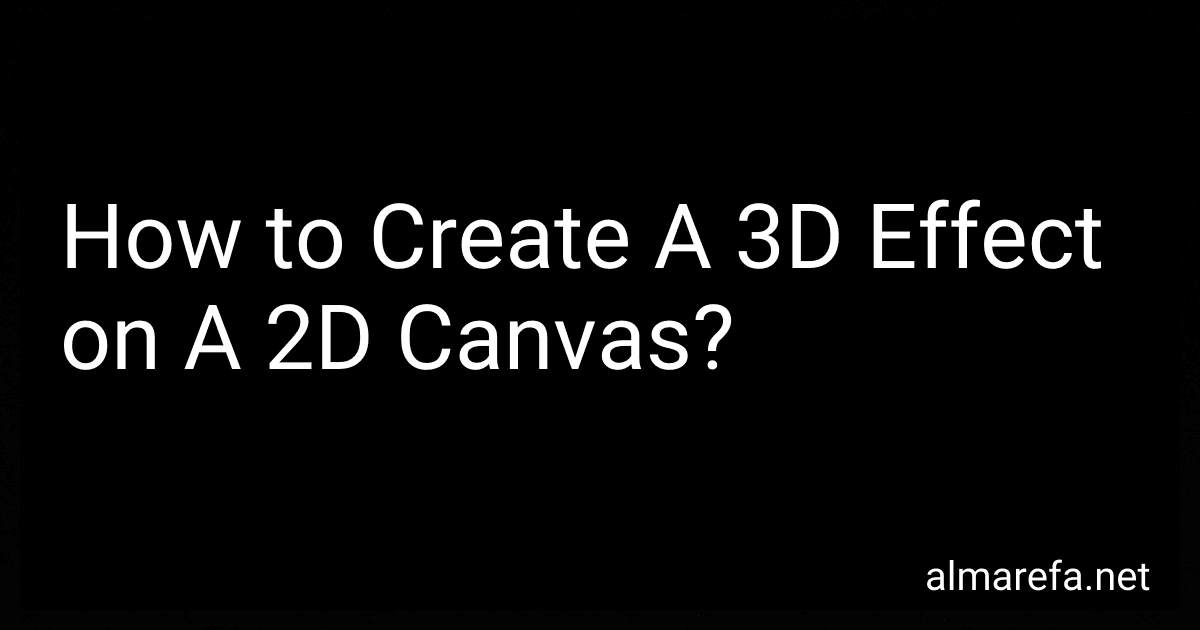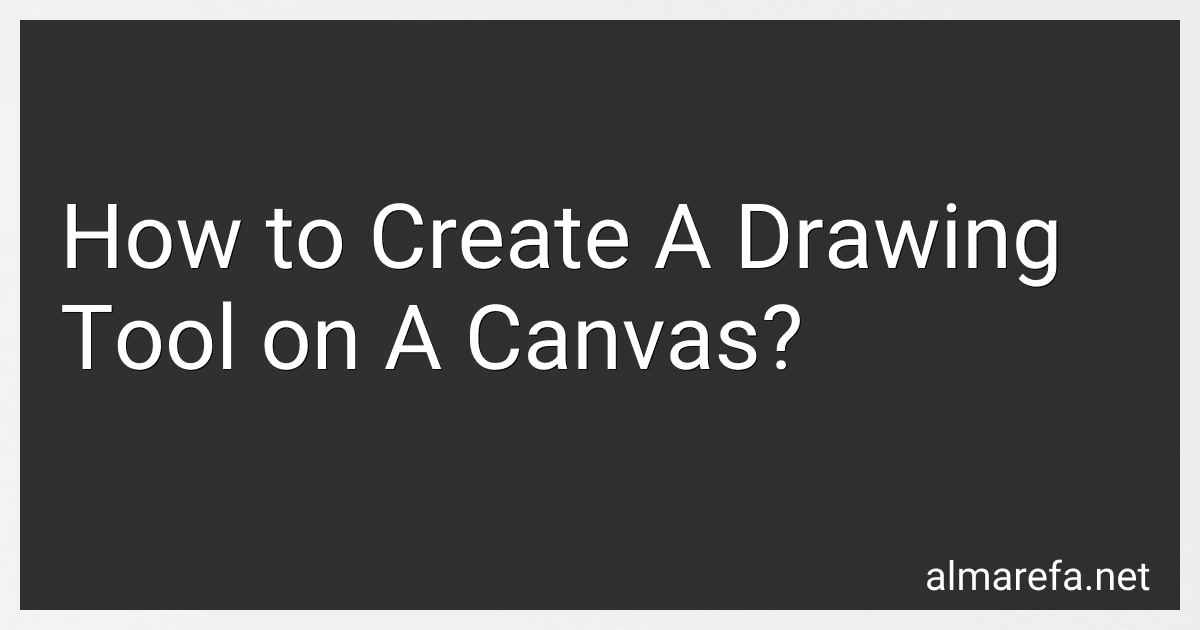almarefa.net
-
 9 min readCreating a 3D effect on a 2D canvas involves using various techniques to simulate depth and dimension. Here are some approaches you can use:Perspective: Start by drawing objects that are further away smaller in size compared to those closer to the viewer. This gives the perception of depth and distance. Shading: Apply shading techniques such as light and shadow to create depth.
9 min readCreating a 3D effect on a 2D canvas involves using various techniques to simulate depth and dimension. Here are some approaches you can use:Perspective: Start by drawing objects that are further away smaller in size compared to those closer to the viewer. This gives the perception of depth and distance. Shading: Apply shading techniques such as light and shadow to create depth.
-
 6 min readImplementing undo and redo functionality on a canvas can be done using a stack data structure. Here's a high-level explanation of how you can achieve this:Create a stack to store the canvas state changes. Let's call it the "undo stack" initially.Keep track of the current state of the canvas.When a change is made on the canvas, such as drawing a shape or moving an object, save the current state of the canvas onto the undo stack.
6 min readImplementing undo and redo functionality on a canvas can be done using a stack data structure. Here's a high-level explanation of how you can achieve this:Create a stack to store the canvas state changes. Let's call it the "undo stack" initially.Keep track of the current state of the canvas.When a change is made on the canvas, such as drawing a shape or moving an object, save the current state of the canvas onto the undo stack.
-
 8 min readPixel manipulation on a canvas involves accessing individual pixels and altering their color values. Here is a step-by-step explanation of how to achieve pixel manipulation on a canvas:Create a canvas element in your HTML file: <canvas id="myCanvas" width="400" height="400"></canvas> Get a reference to the canvas element in your JavaScript code: const canvas = document.
8 min readPixel manipulation on a canvas involves accessing individual pixels and altering their color values. Here is a step-by-step explanation of how to achieve pixel manipulation on a canvas:Create a canvas element in your HTML file: <canvas id="myCanvas" width="400" height="400"></canvas> Get a reference to the canvas element in your JavaScript code: const canvas = document.
-
 9 min readTo effectively use patterns and textures on a canvas, there are a few key principles to consider. First, it's important to understand the difference between patterns and textures.Patterns refer to repeated designs or motifs, while textures involve the physical or visual quality of a surface, such as roughness, smoothness, or the appearance of brushstrokes. Utilizing patterns and textures can add visual interest, depth, and complexity to your artwork.
9 min readTo effectively use patterns and textures on a canvas, there are a few key principles to consider. First, it's important to understand the difference between patterns and textures.Patterns refer to repeated designs or motifs, while textures involve the physical or visual quality of a surface, such as roughness, smoothness, or the appearance of brushstrokes. Utilizing patterns and textures can add visual interest, depth, and complexity to your artwork.
-
 3 min readTo handle keyboard events on a canvas, you need to follow a few steps. Here's an explanation without using list items:First, you need to access the canvas element in your HTML document using JavaScript. You can achieve this by using the document.getElementById() method and passing the ID of your canvas element.Next, you need to add an event listener to the canvas element. The event listener will listen for keyboard events, such as key presses or key releases.
3 min readTo handle keyboard events on a canvas, you need to follow a few steps. Here's an explanation without using list items:First, you need to access the canvas element in your HTML document using JavaScript. You can achieve this by using the document.getElementById() method and passing the ID of your canvas element.Next, you need to add an event listener to the canvas element. The event listener will listen for keyboard events, such as key presses or key releases.
-
 6 min readTo create a drawing tool on a canvas, you can follow these steps:HTML Setup: Start by creating an HTML document and include a canvas element. Give the canvas a width and height using the width and height attributes. JavaScript Setup: In your JavaScript code, get a reference to the canvas element using the document.getElementById() method. Store it in a variable for future use. Context Setup: Obtain the 2D drawing context of the canvas by calling the getContext() method.
6 min readTo create a drawing tool on a canvas, you can follow these steps:HTML Setup: Start by creating an HTML document and include a canvas element. Give the canvas a width and height using the width and height attributes. JavaScript Setup: In your JavaScript code, get a reference to the canvas element using the document.getElementById() method. Store it in a variable for future use. Context Setup: Obtain the 2D drawing context of the canvas by calling the getContext() method.
-
 10 min readShadows and blending modes can greatly enhance the visual appeal and depth of your canvas. By utilizing these techniques effectively, you can create stunning and realistic effects in your artwork. Here's an explanation of how to use shadows and blending modes on a canvas:Shadows:Create a new layer on your canvas and name it "Shadow" or a relevant name.Select the area or object where you want the shadow to appear.
10 min readShadows and blending modes can greatly enhance the visual appeal and depth of your canvas. By utilizing these techniques effectively, you can create stunning and realistic effects in your artwork. Here's an explanation of how to use shadows and blending modes on a canvas:Shadows:Create a new layer on your canvas and name it "Shadow" or a relevant name.Select the area or object where you want the shadow to appear.
-
 7 min readCreating interactive charts with canvas is a powerful way to present data and engage your audience. By utilizing the canvas element in HTML5, you can draw various chart types and enable interactivity for a more dynamic user experience. Here is a step-by-step guide on how to create interactive charts with canvas:Set up the HTML markup: Start by creating a canvas element within your HTML document. Give it an ID attribute so you can reference it later in JavaScript code.
7 min readCreating interactive charts with canvas is a powerful way to present data and engage your audience. By utilizing the canvas element in HTML5, you can draw various chart types and enable interactivity for a more dynamic user experience. Here is a step-by-step guide on how to create interactive charts with canvas:Set up the HTML markup: Start by creating a canvas element within your HTML document. Give it an ID attribute so you can reference it later in JavaScript code.
-
 7 min readTo implement drag-and-drop functionality on a canvas, you can follow these steps:Set up the Canvas: Start by creating a canvas element in your HTML file. Give it a unique identifier so that you can target it in your JavaScript code. Add Event Listeners: Use JavaScript to select the canvas element and attach event listeners for the necessary events: mousedown, mousemove, and mouseup. These events will handle the drag-and-drop functionality.
7 min readTo implement drag-and-drop functionality on a canvas, you can follow these steps:Set up the Canvas: Start by creating a canvas element in your HTML file. Give it a unique identifier so that you can target it in your JavaScript code. Add Event Listeners: Use JavaScript to select the canvas element and attach event listeners for the necessary events: mousedown, mousemove, and mouseup. These events will handle the drag-and-drop functionality.
-
 11 min readTo save and load a canvas drawing, you can follow these steps:Saving a Canvas Drawing: a. Convert the canvas drawing to an image representation using the toDataURL() method of the canvas object. b. Create an element in your HTML. c. Set the download attribute of the element to specify the filename for the saved image. d. Set the href attribute of the element to the data URL obtained from toDataURL(). e.
11 min readTo save and load a canvas drawing, you can follow these steps:Saving a Canvas Drawing: a. Convert the canvas drawing to an image representation using the toDataURL() method of the canvas object. b. Create an element in your HTML. c. Set the download attribute of the element to specify the filename for the saved image. d. Set the href attribute of the element to the data URL obtained from toDataURL(). e.
-
 5 min readTo scale and rotate elements on a canvas, you can follow these steps:Set up a canvas: Create a canvas element in HTML using the tag and set its width and height attributes to specify the canvas dimensions. Provide an ID or class to target it through JavaScript. Access the canvas: Use JavaScript to get a reference to the canvas element either by its ID or class. You can use methods like getElementById() or getElementsByClassName().
5 min readTo scale and rotate elements on a canvas, you can follow these steps:Set up a canvas: Create a canvas element in HTML using the tag and set its width and height attributes to specify the canvas dimensions. Provide an ID or class to target it through JavaScript. Access the canvas: Use JavaScript to get a reference to the canvas element either by its ID or class. You can use methods like getElementById() or getElementsByClassName().